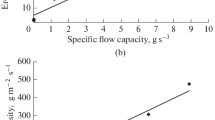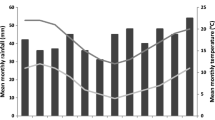Summary
A study was made of the effect on water-stable aggregate distribution of sterilizing soil at three rates of application of ethylene oxide and with heat in the usual manner. Unsterilized soil was used as a basis of comparison.
Aggregation was increased by heat and the two highest rates of ethylene oxide, when soil was sterilized in the air-dry state and analyzed without any further treatment. When a wetting and drying cycle was added to the treatment no significant effects on aggregation could be found.
Aggregation was also increased by heat and by the two lowest rates of ethylene oxide, when soil was wetted and kept at the moisture equivalent under sterile conditions in an incubator for two weeks. The highest rate of ethylene oxide gave no effect in this case. No differences in aggregation were found when the wet soils were incubated after reinoculation with a mixed population.
It appears that ethylene oxide is by no means an ideal sterilizant for aggregation studies. Fairly large quantities are needed to obtain sterilization. Furthermore, use of ethylene oxide results under certain conditions in significant effects on aggregation. In several instances the effects are comparable to effects attributable to heat.
The results of this experiment also indicate that conclusions drawn from experiments where heat sterilized soils are employed can be erroneous if the effect of the sterilization itself is not accounted for.
Résumé
Une étude fut conduite sur l'effet de la stérilisation du sol sur la distribution des agrégats stables à l'eau. Trois doses différentes d'oxyde d'éthylène furent usées pour la sterilisation de même que la methode ordinaire avec chauffage dans une autoclave. De la terre non stérilisée fut usée comme témoin.
L'agrégation s'accrût à la suite du chauffage et des deux doses les plus élevées d'oxyde d'éthylène, quand le soil sèché à l'air fut sterilisé et analysé sans autre traitement. Quand un cycle de mouillage et de dessiccation fut ajouté au traitement, aucun effet significatif ne fut trouvé.
L'agrégation s'accrût à la suite du chauffage et des deux doses les plus basses d'oxyde d'éthylène, quand le sol fut mouillé jusqu'au “moisture equivalent” et fut incubé aseptiquement pendant deux semaines. La dose la plus élevée d'oxyde d'éthylène n'eut aucun effet dans ce cas. Quand le sol fut ensemencé avec une population mixte avant l'incubation, aucun effet sur l'agrégation ne fut constaté.
Il apparait que l'oxyde d'éthylène n'est pas un stérilisant idéal pour des études d'agrégation. Des quantitées assez grandes sont necessaires pour obtenir la stérilité. De plus, l'usage d'oxyde d'ethylène a, dans certaines conditions, des effets sur l'agr%egation. Quelquefois ces effets sont comparables aux effets dûs à la stérilisation par chauffage.
Les résultats des expériences rapportées indiquent aussi que des conclusions tirées des experiences sur des sols sterilisés par chauffage, peuvent être erronées, si l'effet propre de la stérilisation comme telle n'est pas pris en considération.
Similar content being viewed by others
Literature cited
Allison, L. E., Effect of microorganisms on permeability of soil under prolonged submergence. Soil Sci.63, 439–450 (1947).
Clark, F. E., The use of ethylene oxide for soil sterilization. Fourth Int. Congr. Soil Sci. (in press).
Dalton, F. H. and Hurwitz, C., Effect of volatile disinfectants on survival of microflora in soil. Soil Sci.66, 233–238 (1948).
Henin, S., Essay d'une théorie de la stabilité de la structure des sols. Plant and Soil1, 167–178 (1948).
Mazurak, A. P., Effect of gaseous phase on water-stable synthetic aggregates. Soil Sci.69, 135–148 (1950).
Roberts, J. L., Allison, L. E., Pickett, P. S., and Riddle, K. B., Preliminary studies on soil sterilization with ethylene oxide. J. Bact.45, 40 (1943).
Van Bavel, C. H. M., The mean weight-diameter of soil aggregates as a statistical index of aggregation. Soil Sci. Soc. Am. Proc.14, (1949) (in press).
Yoder, R., A direct method of aggregate analysis of soils and a study of the physical nature of erosion losses. J. Am. Soc. Agron.28, 337–351 (1936).
Author information
Authors and Affiliations
Additional information
Journal Paper No. 1768 of the Iowa Agricultural Experiment Station, Ames, Iowa, Project 739.
Rights and permissions
About this article
Cite this article
Van Bavel, C.H.M. Soil aggregate stability as affected by sterilization with ethylene oxide and heat. Plant Soil 2, 395–404 (1950). https://doi.org/10.1007/BF01343359
Received:
Issue Date:
DOI: https://doi.org/10.1007/BF01343359




